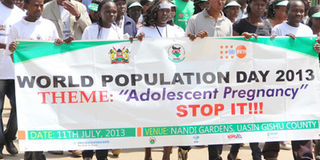39pc of world population to be African by 2100: UN report

Kenyans mark World Population Day on July 11, 2013 in Eldoret Town. Two in every five people in the world will be African by the year 2100, the latest World Population Prospects report shows. FILE PHOTO | JARED NYATAYA |
What you need to know:
- According to the report, Africa will make up a quarter of the world’s population in 2050, and that figure will grow to 39 per cent by the end of this century.
It is expected that of the 2.4 billion people that will be added to the world by 2050, Africa will have contributed 1.3 billion.
This is because Africa has the world’s highest fertility rate at 4.7 children per woman.
Two in every five people in the world will be African by the year 2100, a new report by the United Nations has said.
The UN on Wednesday released the 2015 Revision of World Population Prospects report, which states that Africa will make up a quarter of the world’s population in 2050, and that figure will grow to 39 per cent by the end of this century.
It is expected that of the 2.4 billion people that will be added to the world by 2050, Africa will have contributed 1.3 billion.
This is because Africa has the world’s highest fertility rate at 4.7 children per woman.
NIGERIA FAST GROWER
Of the world’s biggest countries, Nigeria has the fastest-growing population and is expected to by-pass the US as the third most populous in the next 35 years, attaining a population of 399 million people.
It is currently the seventh most populous.
It is also expected that India will replace China as the world’s most populous country in the next seven years.
The projected population growth will be mostly concentrated in the world’s least developed countries, and this is expected to further exacerbate the situation in the resource-poor nations.
Ten African countries that are expected to grow five-fold by 2100 are: Angola, Burundi, Democratic Republic of Congo, Malawi, Mali, Niger, Somalia, Uganda, United Republic of Tanzania and Zambia.
POVERTY BURDEN
“The concentration of population growth in the poorest countries presents its own set of challenges, making it more difficult to eradicate poverty and inequality, to combat hunger and malnutrition, and to expand educational enrolment and health systems, all of which are crucial to the success of the new sustainable development agenda,” said John Wilmoth, director of the UN’s Population Division.
Kenya’s population, which currently stands at 46 million according to the report, is expected to grow to 65 million in 2030, 95 million in 2050 and 156 million in 2100.
In sharp contrast, the populations of 48 countries or areas in the world are expected to shrink between 2015 and 2050.
FERTILITY CRISIS
“Several countries are expected to see their populations decline by more than 15 per cent by 2050, including Bosnia and Herzegovina, Bulgaria, Croatia, Hungary, Japan, Latvia, Lithuania, Republic of Moldova, Romania, Serbia, and Ukraine,” states the report.
This is attributed to very low fertility rates, far below the replacement level of 2.1 children per woman.
Overall, people are expected to start living longer, with life expectancy set to rise from the current 70 years to 77 years in 2050 and 83 years in 2100.
The report, however, warns that “such increases are contingent on further reductions in the spread of HIV, and combating successfully other infectious as well as non-communicable diseases.”





